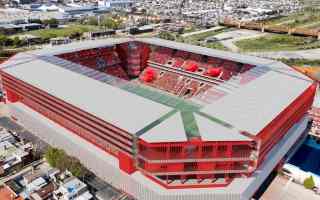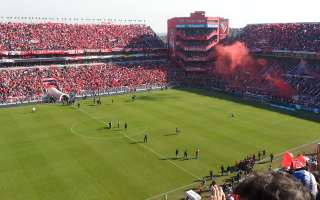Estadio Libertadores de América (La Doble Visora)
| Capacity | 42 069 |
|---|---|
| Country | Argentina |
| City | Avellaneda |
| Clubs | CA Independiente |
| Inauguration | 28/10/2009 (Independiente - Colón, 3-2) |
| Construction | 2007-2017 |
| Cost | $ 50 million (?) |
| Design | Ezequiel Fernandez Dorado |
| Address | Ricardo Enrique Bochini 751, Avellaneda, Buenos Aires, Argentina |
Advertisement
Estadio Libertadores de América – stadium description
What did Estadio Independiente look like?
The origins of Estadio Independiente can be traced back to 1925, when the Independiente club purchased 6 hectares of land to build a new stadium, just a few metres from the Estadio Racing Club.
The old Estadio Independiente was opened in 1928 as the first stadium in Argentina with reinforced concrete stands (second in the world after Harvard Stadium). Most of the auditorium was in an earthen trough, making the construction more economical for the club. The decision to build the stadium with fireproof materials was made in response to the Crucecita fire in 1923.
For most of its existence, the stadium was nicknamed La Doble Visera de Cemento
due to its distinctive two-part roof.
Why was it decided to build new Estadio Libertadores de América?
At the beginning of the 21st century, the stadium was already in a poor state of repair. In 2006, half an hour before a match against San Lorenzo, a section of the wall fell off and fell onto the press stand, fortunately causing no injuries. That same year, Independiente sold Sergio Agüero to Atlético Madrid for €23 million. Both of these events may have accelerated the decision to build a new venue.
The last match at the historic Doble Visera
was on 8 December 2006 against Gimnasia y Esgrima de Jujuy. Demolition of the old stadium began in January 2007 and the new Estadio Libertadores de América was erected in its place.
How many ideas were there for Estadio Libertadores de América?
The distinguished Estadio Independiente ended its existence for Argentine football in the 21st century. Exactly 80 years after the construction of the Doble Visera
began, in 2005, the club's president, Julio Comparada, presented a plan to build a completely new stadium.
Three designs were considered. The first of these appealed to the fans, but was rejected due to the excessive cost of implementation. During the demolition of the old stadium, the second design was the most considered, but in mid-2007 a third, simplified variant of the first design was decided upon. In the end, Estadio Libertadores de América was built at a cost of $80 million. The project was designed by architect and Independiente supporter Ezequiel Dorado.
What did first years of the Estadio Libertadores de América look like?
The symbolic inauguration of the Estadio Libertadores de América took place on 25 November 2008, just before the club elections. Three days later, the official opening took place during a match between Independiente and Colón de Santa Fe. Interestingly, the opening took place when the stadium was only 60% complete.
In 2014, due to the club's financial crisis, work on the stadium was halted. Even then, the facility was already regarded as neglected. The stadium was only completed in 2016.
Since its inception, the stadium has been called Estadio Libertadores. This name won the fan vote as a tribute to the seven tournaments Independiente won. In December 2021, the name of the stadium was changed to Libertadores de América-Ricardo Enrique Bochini,
in honour of legendary player Ricardo Bochini, who played for Independiente throughout his career between 1972 and 1991.
What does Estadio Libertadores de América look like?
Estadio Libertadores de América has four straight, two-storey stands. Boxes have been placed on the stands along the pitch between the floors. In the corners are four towers, known as devil's throats.
Each tower has four small grandstand sections with premium seating, located one above the other.
The lower sections of the stands behind the gates have standing room, while the other sections of the stands are equipped with plastic chairs. The stand behind the north goal is named after Miguel Ángel Santoro, and behind the south goal Ricardo Elbio Pavoni.
A canopy is missing over the stands of the Estadio Libertadores de América. On the outside, no facade was made, leaving a bare reinforced concrete frame. Despite the austerity, the stadium gives a decent impression of a football facility of European standards.
The stadium is located in the city of Avellaneda, which is part of Greater Buenos Aires, less than 10 km from the centre of the conurbation. Right next to the Estadio Libertadores de América is another large stadium, Estadio Presidente Perón, belonging to CA Independiente's derby rival, the Racing Club team.
What sporting events have taken place at the Estadio Libertadores de América?
In addition to Argentine league matches involving Independiente, the stadium has also hosted several finals of international tournaments. In 2010 and 2017, the Copa Sudamericana finals were played here, and in 2011 and 2018, the finals of the Recopa Sudamericana, the South American equivalent of the Super Cup, in which the Copa Libertadores and Copa Sudamericana champions clash.
The Estadio Libertadores de América was also one of the venues for the Copa Argentina 2024 and hosted one match for the Argentine national team at the 2022 Rugby Championship. The stadium also hosted a friendly rugby match between the Los Pumas team and the French Barbarians.
Advertisement
Pictures
-

15.04.2024 © RAsenReisen 
30.04.2016 © Morten F 
15.04.2024 © RAsenReisen 
30.04.2016 © Morten F 
30.04.2016 © Morten F 
30.04.2016 © Morten F 
30.04.2016 © Morten F 
30.04.2016 © Morten F 
30.04.2016 © Morten F 
30.04.2016 © Morten F 
08.06.2014 © AlexRojo93 (cc: by-sa) 
15.04.2024 © RAsenReisen 
15.04.2024 © RAsenReisen 
15.04.2024 © RAsenReisen 
15.04.2024 © RAsenReisen 
15.04.2024 © RAsenReisen 
15.04.2024 © RAsenReisen 
15.04.2024 © RAsenReisen 
28.07.2016 © Estadio LDA
Related news
2025
-

Argentina: 16,000 new seats, museum and roof for Independiente stadium!
The modernisation plan for Libertadores de América includes increasing the stadium's capacity, building a car park and creating a modern club museum. All this will be done without the club having to invest any of its own funds, thanks to cooperation with investors.
-

Argentina: Independiente wants a world-class stadium... for free
Built with money from the sale of Sergio Agüero. Opened when half of the work was completed. Stripped of a roof and facade to save money. Estadio Libertadores de America will undergo a major overhaul, but CA Independiente has an original plan: it won’t pay a single peso for it.
 StadiumDB
StadiumDB